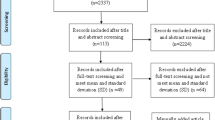Abstract
Lead has no biological function and is one of the most toxic metals. Of several heavy metals, monitoring of lead is an important focus in occupational medicine. In exposure and risk evaluation, monitoring lead biologically has several advantages over technical exposure assessment. In this article, the authors report a very high blood lead level among the Mahayana Buddhist monks. This is a forgotten high-risk population. The environmental implication in the monitoring and controlling of this population is raised.
Similar content being viewed by others

References
Apostoli P (1998) Trends in lead exposure in the work place and the environment. Ann Ist Super Sanita 34:121–129
Christensen JM (1995) Human exposure to toxic metals: factors influencing interpretation of biomonitoring results. Sci Total Environ 166:89–135
Fang GC, Chang CN, Chu CC, Wu YS, Pi-Cheng Fu P, Chang SC, Yang IL (2003) Fine (PM2.5), coarse (PM2.5–10), and metallic elements of suspended particulates for incense burning at Tzu Yun Yen temple in central Taiwan. Chemosphere 51(9):983–991
Herman DS, Geraldine M, Scott CC, Venkatesh T (2006) Health hazards by lead exposure: evaluation using ASV and XRF. Toxicol Ind Health 22:249–254
Lin TS, Shen FM (2003) Trace metals in Chinese joss stick smoke. Environ Contam Toxicol 71:135–141
Richter ED, Fischbein A (1992) Lead poisoning: II. Biological standards for occupational lead exposure–where do we stand now? Isr J Med Sci 28:572–577
Shotyk W, Le Roux G (2005) Biogeochemistry and cycling of lead. Met Ions Biol Syst 43:239–275
Skerfving S, Nilsson U, Schutz A, Gerhardsson L (1993) Biological monitoring of inorganic lead. Scand J Work Environ Health 19(Suppl 1):59–64
Toscano CD, Guilarte TR (2005) Lead neurotoxicity: from exposure to molecular effects. Brain Res Brain Res Rev 49:529–554
Winneke G, Lilienthal H, Kramer U (1996) The neurobehavioural toxicology and teratology of lead. Arch Toxicol Suppl 18:57–70
Wiwanitkit V, Suwansaksri J (2006) Lead intoxication: a summary of the clinical presentation among Thai patients. Biometals 19:345–348
Yang HH, Jung RC, Wang YF, Hsieh LT (2005) Polycyclic aromatic hydrocarbon emissions from joss paper furnaces. Atmos Environ 39:3305–3312
Author information
Authors and Affiliations
Corresponding author
Rights and permissions
About this article
Cite this article
Wiwanitkit, V., Suwansaksri, J. & Soogarun, S. High blood lead level among the Mahayana Buddhist monk: a note for environmental implication. Stoch Environ Res Risk Assess 22, 805–807 (2008). https://doi.org/10.1007/s00477-007-0188-0
Published:
Issue Date:
DOI: https://doi.org/10.1007/s00477-007-0188-0



